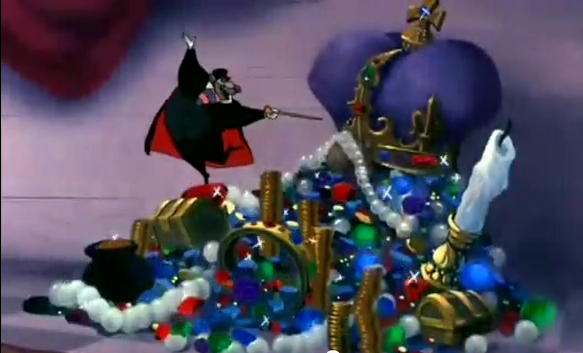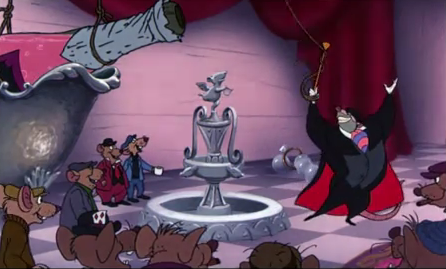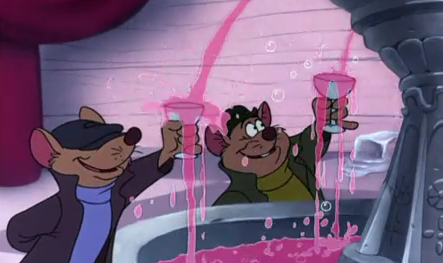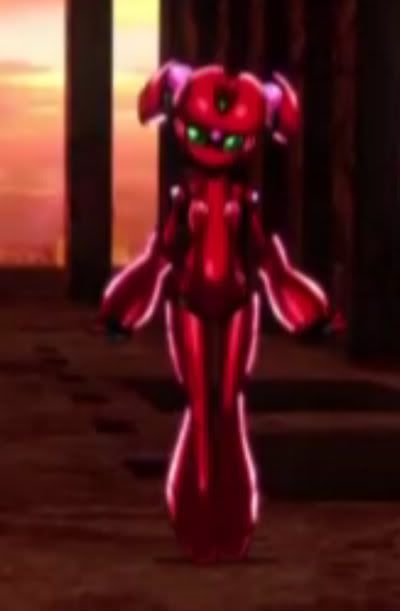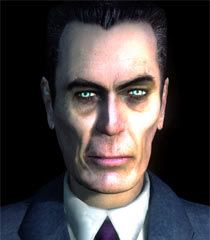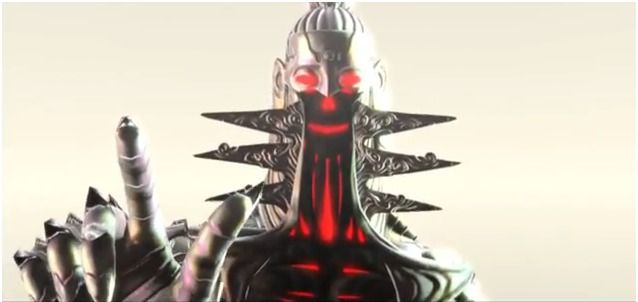This is my MYMini entry. Fo shizzle.
Two-Headed King Rex is a pretty generic Normal Monster in the Yu-Gi-Oh! Trading Card Game. About the only notable thing is it was used a few times by Rex Raptor in the anime. Fun fact! It's Japanese roar is actually what was used in the dub for Blue-Eyes White Dragon's roar, because the dubbers thought that the unique roar would better be suited to a major monster then one that appears for maybe five minutes in three episodes.
Statistics
King Rex here stands a little taller than Ganondorf in height and just a bit less wide than Bowser, giving him a very large size. Despite this, he is not as heavy, being a little lighter than Donkey Kong, which is not a good combination. On the plus side, though, it is a good deal more agile than all of those, being a bit faster than Donkey Kong with good traction.
He is also somewhat decent in the air, having above average airspeed but just a tad below average control. It's wings let it go a bit higher in the air, but it's not an aerial player nor can they carry it's large body too far, so it only gets a single extra midair jump. It also has a glide, though it drops pretty fast due to it's weight. On the plus side, it won't put you into helpless if you are out of jumps, even if you can't glide again until you land. So, uh, whoo.
Oh, he also has a mechanic...
Mechanic: Two as One
King Rex's mechanic comes from the primary and obvious thing about it: It has two heads! This means that during many moves, mostly involving the heads, King Rex can actually attack during it with it's other head, allowing him to have two hitboxes out at once. Theoritically speaking, you could use this to infinitely attack...but you can't move, so you won't be getting anyone outside of your range, and it's not like this erases end lag or start lag either...
Special
Neutral Special: Flame Breath
King Rex is one of the few dinosaurs ever seen to use fire breath in the anime, so somewhat unsurprising it has one. With this, King Rex lurches one head forward, blowing out a billowing breath of fire. This has a bit shorter range than Bowser's version, but it decays half as fast and recharges twice as fast. It deals very similiar damage, little hits of around 2% that cause flinching, it's easy enough to DI out of.
Notice how I said that one head lurches forward, though? You can still use head-based attacks with your other head while this is going on, even using this very move again, in which case the other head will turn to the side opposite the first one and start blowing fire on it's own timer, causing you to cover both sides of you. Very nice! Tap B to start this move, then either tap it again for the second flame breath or hold it down to stop the move before the second head. Or input another appropriate possible move to use it. The two heads have different recharge times, so remember that!
Down Special: Earthrocker
King Rex raises both of it's clawed hands high, balled into fists, before slamming them into the ground. This mighty if somewhat slow to start slam does 17% damage and pretty high knockback, KOing around...oh...let's say 110%.
The key thing that happens, though, is that when you slam against the ground, two rock spikes jut up from the stage, uprooted from the force of your blow. These will pretty much never hit if you hit with the fists, but if you whiffed, they'll deal a keen 10% and about 140% killing knockback. The tops of the spikes remain a hitbox while they are out, dealing 7% damage and set knockback that isn't too high, but is high enough that you can DI away from them after getting hit once. These will stay out on the field for a solidly long 12 seconds, but they will steadily get smaller over that time, until during the last second only the tips barely stick out. This is a solid way for King Rex to slightly make the stage more to his liking or simply as an annoying damager and wall offer. Use it at will, but note the end lag is poor.
Because of the way that King Rex raises and lower it's arms during this move, you can't use your heads during it.
Side Special: Rockcrasher
King Rex slams a fist in front of him, sending a shockwave through the earth. The shockwave travels slowly, a bit slower than Ganondorf's dash speed, so you can easily outrun it. But what does it do?
Well, when it gets half a Battlefield platform close to any foe, the shockwave shoots up and causes a chunk of the stage, about Bowser-sized, to shoot up at the foe. This chunk deals some good damage at a solid 12% and similiarly solid knockback that kills at around 130%. Unless it hits a wall or something, it'll go flying off the stage. If it hits a wall though, it will fall to the ground and stay there, like a little on-the-ground slightly-elevated platform rock thing. All the same, the area where the rock got ejected out of will form a small pit the size of the stage that got shot out.
If this move itself would go into one of those pits, then it wll follow it or in other words, go under it. This can be an effective way to delay it a little or to hit people who get in there and stay in there. Because of the fact that it goes slower than you, it can also be used as an approach or psuedo-moving-trap.
The starting lag with this is a bit slow, but the ending lag isn't bad. Useful for approaching. Do not that just like the Down Special, you can't attack with your heads at the same time.
Up Special: Wingflapper
King Rex musters all of his strength and flaps his wings hard. This causes a small wind hitbox in front of him, pretty weak, but more importantly causes him to raise up. In essence, he goes up about half the size of Wings of Icarus, but unlike that move, King Rex can use this again if he's hit out of it. It's really just a boring recovery, though.
It's a one day set, gimme a bit of a break, eh?
Standards:
Jab: Swipe
King Rex swipes once, then if you hit A, swipes again with his claws. It's really just a basic jab...3% damage followed by 4% on the second, slightly stronger swipe. This move does have some decent knockback on the second hit, though, killing at roughly 210%. The first hit can be used with head attacks, but the way the second's animation goes means it can't. And, of course, if you use the first attack to lead into a head attack, you can't use the second hit. Both hits come out very fast, like a good jab, with minimal ending lag. So whoo.
Forward Tilt: Bite
King Rex sends one mouth forward, extending it's neck to the best of it's ability to give it extremely good range, somewhere in the area of 3/4th of a Battlefield platform, before biting down. The bite itself is fairly strong, dealing a neat 11% damage and...odd knockback. You see, King Rex actually flicks his head up a little when it bites, causing the foe to follow that trajectory if hit, or in other words, this attack causes the foe to be dealt backwards-upwards knockback. It has decent base knockback, but the knockback scaling keeps it from killing until...let's say 170%.
It starts out fairly fast and has average ending lag.
As you may have guessed, the odd knockback properties are used, especially when you consider that you have a head you can attack with behind you...
Up Tilt: Chomp
King Rex's head shoots up in a way that practically mirrors Bite, except it's upwards, chomping down on the foe for 11% damage and some good knockback that kills at around 155%. This move's key use is forming a combo with the Forward Tilt. At lower damage %s and/or on bigger characters, this forms a true combo, or in other words it will always hit if done right, while later on it provides a non-true combo which can be DIed out of. Smaller characters and characters with higher %s are easier able to DI away and make it a non-true combo sooner. It's lag is similiar to Bite in all ways.
Use this to rack up damage at lower %s with Bite or simply as an anti-air move. Obviously, Bite and Chomp are two head attacks that can be used at any time, so don't be afraid too.
Down Tilt: Stomp
King Rex gives a hard stomp to the ground just in front of him. This move has high damage and knockback for a tilt, 14% and vertical knockback that kills at around 120% respectively, but it's hitbox is incredibly small, essentially being "right next to King Rex". Combined with it's somewhat lengthy start lag, though it has little end lag, it's hard to hit with.
This move has a somewhat well hidden secondary use, though, which is that it sends a small little shockwave diagonally through the ground, which has the same knockback properties as the tilt itself. While it normally won't do anything, if an opponent is hiding inside the stage or, more importantly, if it manages to go through the stage, such as if used close enough to the edge or next to a pit, it will exit the ground and retain it's shockwave/knockback properties, decaying somewhat quickly but being a good-sized moving hitbox. Because of the low ending lag, you can use this close to a pit, hit a foe trying to get out of a pit back into it, then when they get hit up from the tilt, try to hit them back in again! Pretty neat, don't you think?
Down Smash: Shockcrack
King Rex raises it's arms high in an animationg disturbingly similiar to it's Down Special, before bringing them down for 15-19% damage and good KOing knockback, KOing at precisely 100%. It has somewhat good range due to the size of King Rex's arms, but it's got a bit heavy starting lag, although it's ending lag is fairly low for a smash attack.
The key thing for this move though is the creation of shockwaves from it's impact, one to each side. These shockwaves don't do much to foes, though the 1% and tripping is much appreciated, but will also cause shockwaves from your Side Special to end prematurely, allowing you to shoot out the rock at any time and giving you greater control of your pit placement. While not necessarily an interaction, they also run over the top of the pits bottoms, meaning foes can be tripped a lot if they are stuck inside a pit when King Rex launches this move. Learn the intricacies of this move and it will serve you well.
Forward Smash: Fireballer
King Rex quickly spits out a fireball of about 1.5x Kirby's size in front of him. This move has pretty quick start-up for a smash attack, although it's end lag is slightly above average, as the fireball travels 2 Battlefield platforms, dealing 14-17% damage and knockback that only kills at a somewhat dissapointing 145%.
This move, like many tilts and smashes, can be angled up and down, which provides some ways to switch it up. Angle it up and the fireball will be sent at a diagonal arc, hindering aerial approaches, getaways and general shenanigans, while pressing down does the opposite, sending it downwards, which is seemingly useless, although it can hit in a pit, I suppose...
Except that when the fireball stops, it leaves behind a lingering fire hitbox for 3 seconds. So down-angling not only allows you to hit a pit, but fill that pit with fire, particularly small pits can be even entirely filled with pits and force the foe into an unwanted DI position, while upward-angled fireballs will have their lingering hitbox gently fall to the earth, making it a sort of falling trap. The lingering hitbox deals constant 2% damage with virtually no knockback, necessitating either DIng away or being hit out of it.
And, of course, there's the value of having a long-range projectile you can fire while attacking thanks to being able to use it with head attacks...
Up Smash: Head Crack
King Rex whips a head upwards while hopping a little. Compared to his other two smashes, it's a bit generic, although it has average lag on both sides, making it a good middle of the road option. It's a decent but not great KOer, knocking out at 125%, and deals a solid enough 15-18% damage. It also has some pretty good range thanks to hopping plus the good extension of King Rex's neck.
The primary fun thing to do with this? Combine it with another head attack thanks to the hop! You can basically short hop a grounded head attack and do some odd things, such as giving yourself new angles with the F-Smash or an easier time catching aerial foes with the F-Tilt or the like. Aside from that, it's just a strong upwards attack, standard for an Up Smash.
Dash Attack: Chase Chomp
King Rex slows down to 3/4th of it's normal dashing speed, while it's head chomps madly in front of it, being a constant hitbox of 10% damage that KOs at a late 180%. This is a somewhat odd keep dashing attack, as King Rex won't stop the attack until he reaches a ledge or until you hit A
without a direction again, which allows you to use another head move while using this. In essence, you can now perform a head move while staying on motion, allowing you to do weird things like fire of fireballs behind you while moving forward or essentially short hop with your Up Smash. It's simple, but pretty neat, huh? Unfortunately, you can't dash in the middle of an actual attack, so this has to be the first attack if you want to do those.
Do note that your dashing speed is slowed and this has some decent end lag, though. The start lag is very low, however.
Grab Game
Grab:
King Rex's grab is somewhat normal, and yet somewhat not. It functions as an ordinary of nicely ranged grab, as King Rex extends it's neck and tries to grab the foe in it's jaws, it's range about the same as His Royal Penguini. It has oddly long ending lag if you miss, though...
Well, not entirely oddly. Because 1. This is a head attack you can use another attack during! But perhaps more importantly, 2. This is an extremely angle-able grab, in addition to the fact you can grab with your other head, which also allows you to grab multiple opponents(You throw the first one you grabbed first). Angle-able, you say?
Yes, angle-able. When you input the grab, flick the control stick in a direction and the head will shoot out to try and grab in that direction! You can shoot it out in eight directions, up/down/left/right and the diagonals, giving you unprecedented control over where your grab goes and the ability to grab aerial foes. Combined with the potential double-grab and you have a very dangerous grabbing game.
Pummel: Chew
King Rex chews on the foe for 2% damage. Average speed pummel. If you have two foes grabbed, it pummels both.
Forward Throw: Indigestion
King Rex...does not actually throw the foe. Instead, it begins breathing fire up while continuing to hold them in it's mouth, dealing 2% damage at a fairly fast rate. Opponents must simply escape the grab, any progress they have made escaping up until this is used is counted of course, to get out. Needless to say, the more damage on the foe, the more you can rack up with this. It goes faster than the pummel, so don't bother with the pummel if you plan on this throw.
While in this state, you must be careful, as you want to
throw the foe away by hitting A before they escape, which will cause King Rex to lightly toss the foe forward for 6% damage and weak knockback and hitstun. If you don't do it before they escape naturally, they will escape in a frame advantage and probably get a quick attack off on you, plus you miss out on 6% damage...but of course, you want to squeeze out all the damage you can...
Back Throw: Flame Spitter
King Rex tosses the foe backwards and spits a fireball at it. It's quicker and so only half as big as the Forward Smash fireball, deals only 9% damage(The toss itself does 5%, so 14% if it all hits) and disappear after only a Battlefield platform. AND the fireball can be DI'd away from at a reasonable %! Terrible.
The good thing about this throw is that the angle of it allows you to hit someone who has been grabbed by your other hitbox to be hit by the fireball instead of the person you throw, allowing you to rack damage on the second person in exchange for losing damage on the first. So that is sort of nifty.
Down Throw: Flare Burst
King Rex throws the foe to the ground and pins them under one of it's feet, which deals 3% damage, before spitting a big burst of fire right into their face, which extends against the stage half a Battlefield platform to each side. The fire deals 10% damage, although it is too shallow to hit any other grabbed foes due to the grab animation, and sends knockback that doesn't KO until 250% onto the foe. What this does do, however, is superheat the floor for the next three seconds. This causes anyone who stands on it to take 1% damage per 1/4th second they are on it, giving a bit of an annoying damage bonus to people in an area. This will go right over pits, though, and not superheat them.
Of course, if they go down there to hide, they are vulnearable to you, aren't they?
Up Throw: STRONG Toss
King Rex's most simple throw. He simply gives the foe a mighty upwards toss, which deals 12% damage and is his best KOing throw, though it still only KOs starting at 175%. Straight vertical knockback. Nothing else really interesting about it.
Aerials
Neutral Aerial: Quick Bite
King Rex does a very quick bite in front of it. It doesn't extend far, so it doesn't have as much range as a normal King Rex move, but it gains a lot of speed from this, coming out quick and having little end lag, making it a useful quick GTFO move. It deals decent but not really killing knockback. It's damage output is poor though, a meager 6%. Hit A and the other head will bite behind you, or use another head-based aerial to work with this!
Forward Aerial: Headmasher
King Rex rears a head back, before slamming it forward. Most of it is a sourspot, dealing 12% damage and good but not great upwards knockback, but if you hit with the head-part while it is swinning down, it turns into a fairly strong meteor smash that deals 14%. This has a pretty fast start-up surprisingly and not too bad of end lag either, but the sweetspot is a bit hard, so you'll mostly just be using this as a fairly strong forward-based attack or as an alternative to your Down Aerial spike, which is more suited for pit shenanigans than off-stage or mid-air spiking.
Down Aerial: Smashfoot
King Rex raises a foot high before slamming it down, providing a powerful spike with an extreme 15% damage too it...though it has some really bad starting lag. The ending lag is virtually non-existant, though, but this makes it hard to land on people in open space. It's primary use is that it can make it hard to escape pits, due to the vastly decreased range of dodging possibilities, making it a superior pit-trapping option to the forward aerial. Not much else really special there.
Back Aerial: Headswinger
King Rex swiftly swings one of its heads behind it, dealing 11% damage and somewhat low knockback, though it starts out quite quick, even if it's not as fast as the Neutral Aerial. It has somewhat odd ending lag though, a little heavy. It's your basic backwards aerial GTFO, but you can do some pretty neat stuff with it and your FAir and NAir. At least covering a lot of space, you know? And it can make it hard to air dodge away...
Up Aerial: German Dinoplex
The only really interesting King Rex aerial. King Rex...reaches up and tries to grab the foe? Oh my god, it's the dreaded aerial grab hitbox! It's pretty much only right on top of him, so it's a bit tricky to hit with...
...But land it and King Rex will, with all of his might, rocket upwards! It's very similiar to other suplex-style moves like Kirby's up throw. Anyway, King Rex will soon come back down with the foe: If you were off-stage, this is a pretty easy KO, but if you land on the stage, you'll get a solid hit of 12% in and the foe will land in prone in front of you. While this might not be the most useful thing ever on flat ground, they can just roll away and all, but with a wall nearby or in a pit, the foe's get-up options can be quite limited and allow you to do some fun things. This has a bit bad ending lag if it whiffs, but at least starts well.
Final Smash: King Kong Rex
King Rex turns into a generic giant form. It's 6:10 AM, I do not feel like messing with a final smash.
Playstyle
King Rex's playstyle? Not too complex...King Rex damage racks with some low level combos using it's two heads at the start, while you want to use your pits and the stage projectile from them to somewhat limit the foe's options, which along with the rock spikes can leave the foe a bit pressed for options.
And when you litter the stage with some residual fire or throw in some tripping from your D-Smash or become a moving death-hitbox of doom with your Dash Attack + Head Attacks? Well, then the foe is in trouble.
You do have some annoying issues, though. Your only real way to deal with projectiles is the rock spikes or to hide in pits, so campers can be annoying, and you do not really have a great aerial game. You want to keep foes grounded and/or in pits where you can rip them up and spit them out. In FFAs, your grab possibilities are also quite nice, with your damage racking F-Throws and the like.
This section might be a bit poor, but it's a one day set that I did not spend most of the day on and it's now 6:20 AM as I finish this. Cut me some slack.



